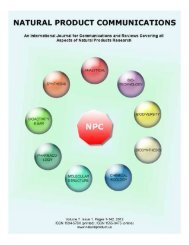This Issue is Dedicated to the Memory of Professor Ivano Morelli
This Issue is Dedicated to the Memory of Professor Ivano Morelli
This Issue is Dedicated to the Memory of Professor Ivano Morelli
Create successful ePaper yourself
Turn your PDF publications into a flip-book with our unique Google optimized e-Paper software.
1114 Natural Product Communications Vol. 1 (12) 2006 Bilia et al.<br />
Preparation <strong>of</strong> <strong>the</strong> decoctions: Sample D1: A 9 g<br />
sample <strong>of</strong> dried aerial parts <strong>of</strong> sweet wormwood was<br />
extracted with 1 L <strong>of</strong> boiling water, kept boiling for 5<br />
min, <strong>the</strong>n left <strong>to</strong> cool and filtered. Sample D2: A 9 g<br />
sample <strong>of</strong> dried aerial parts <strong>of</strong> sweet wormwood was<br />
extracted with 1 L <strong>of</strong> boiling water, kept boiling for<br />
5 min and immediately filtered. Sample M: A 9 g<br />
sample <strong>of</strong> pieces <strong>of</strong> sweet wormwood was treated<br />
with 1 L <strong>of</strong> water, kept boiling for 5 min in a<br />
microwave oven, <strong>the</strong>n left <strong>to</strong> cool and filtered. For<br />
analytical purposes, all <strong>the</strong> filtrates were lyophilized<br />
and provided 2.15 g, 2.09 g, and 3.16 g <strong>of</strong> dried<br />
product, respectively.<br />
Preparation <strong>of</strong> <strong>the</strong> infusions: Sample 11: A 9 g<br />
sample <strong>of</strong> dried sweet wormwood was extracted with<br />
1 L <strong>of</strong> boiling water, <strong>the</strong>n left <strong>to</strong> cool and filtered.<br />
Sample 12: A 9 g sample <strong>of</strong> dried aerial parts <strong>of</strong><br />
sweet wormwood was extracted with 1 L <strong>of</strong> boiling<br />
water, covered, <strong>the</strong>n left <strong>to</strong> cool and filtered. Sample<br />
13: A 9 g sample <strong>of</strong> dried aerial parts <strong>of</strong> sweet<br />
wormwood was extracted with 1 L <strong>of</strong> boiling water,<br />
<strong>the</strong>n left <strong>to</strong> cool for 15 min and filtered. For<br />
analytical purposes, <strong>the</strong> filtrates were lyophilized,<br />
providing 2.04, 1.89 and 3.44 g <strong>of</strong> dried product,<br />
respectively.<br />
Table 3: Mobile phases used for HPLC analys<strong>is</strong>.<br />
Time(min) A % B % C % Flow (mL/min)<br />
0.00 50 50 0 1.000<br />
15.00 50 50 0 1.000<br />
20.00 0 0 100 1.000<br />
23.00 0 0 100 1.000<br />
28.00 50 50 0 1.000<br />
HPLC-DAD and HPLC-MS systems: The HPLC<br />
analyses were performed using a HP 1100 Liquid<br />
Chroma<strong>to</strong>graph (Agilent Technologies, Palo Al<strong>to</strong>,<br />
CA, USA) equipped with a HP 1040 Diode Array<br />
Detec<strong>to</strong>r (DAD), an au<strong>to</strong>matic injec<strong>to</strong>r, an au<strong>to</strong><br />
sampler, a column oven and managed by a HP 9000<br />
workstation (Agilent Technologies, Palo Al<strong>to</strong>, CA,<br />
USA).<br />
Separations were performed on a reversed phase<br />
column Purospher®Star RP-18, namely Hibar®. The<br />
HPLC system was interfaced with a HP 1100 MSD<br />
API-electrospray (Agilent Technologies, Palo Al<strong>to</strong>,<br />
CA, USA). The interface geometry, with an<br />
orthogonal position <strong>of</strong> <strong>the</strong> nebulizer with respect <strong>to</strong><br />
<strong>the</strong> capillary inlet, allowed <strong>the</strong> use <strong>of</strong> analytical<br />
conditions similar <strong>to</strong> those <strong>of</strong> HPLC-DAD analys<strong>is</strong>.<br />
Mass spectrometry operating conditions were<br />
optimized in order <strong>to</strong> achieve maximum sensitivity<br />
values: gas temperature 350°C at a flow rate <strong>of</strong> 10<br />
L/min, nebulizer pressure 30 p.s.i., quadrupole<br />
temperature 30°C, and capillary voltage 3500 V. Full<br />
scan spectra from m/z 100 <strong>to</strong> 800 in <strong>the</strong> positive ion<br />
mode were obtained (scan time 1 s).<br />
A prepacked column RP (250 x 4.6 mm) with particle<br />
size 5 µm (Merck, Darmstadt, Germany) was<br />
employed. The eluents were A: water adjusted <strong>to</strong> pH<br />
3.2 with formic acid; B: ace<strong>to</strong>nitrile; C: methanol.<br />
The mobile phase <strong>is</strong> reported in Table 3. The system<br />
was operated with oven temperature at 26 o C. Before<br />
HPLC analys<strong>is</strong>, each sample was filtered through a<br />
cartridge-type sample filtration unit with a<br />
polytetrafluoroethylene (PTFE) membrane (d = 13<br />
mm, porosity 0.45 µm, (Lida Manufacturing Corp.)<br />
and immediately injected.<br />
Chroma<strong>to</strong>grams were recorded between 200 and 450<br />
nm. DAD spectra were s<strong>to</strong>red for all peaks exceeding<br />
a threshold <strong>of</strong> 0.1 mAu.<br />
Calibration curves: A calibration curve, obtained<br />
from a methanolic solution <strong>of</strong> artem<strong>is</strong>inin (1 mg/mL),<br />
was used <strong>to</strong> quantify artem<strong>is</strong>inin in n-hexane extracts<br />
and tinctures, while a methanolic solution <strong>of</strong><br />
artem<strong>is</strong>inin (0.5 mg/mL) was employed <strong>to</strong> determine<br />
<strong>the</strong> artem<strong>is</strong>inin content <strong>of</strong> infusions and decoctions.<br />
The flavonoid amounts were quantified by a<br />
methanolic solution <strong>of</strong> rutin international standard<br />
0.03 mg/mL.<br />
Sample analys<strong>is</strong>: Samples <strong>of</strong> 5 mg <strong>of</strong> <strong>the</strong> different<br />
extracts were accurately weighed and suspended in<br />
methanol (1.0 mL). The suspensions were sonicated<br />
for 10 min and filtered through a cartridge-type<br />
sample filtration unit before HPLC analys<strong>is</strong>. The<br />
tinctures were injected as prepared.<br />
Acknowledgments - The financial support <strong>of</strong> MIUR<br />
(PRIN 2004) and Ente Cassa di R<strong>is</strong>parmio di Firenze<br />
are gratefully acknowledged.<br />
References<br />
[1] Klayman DL. (1985) Qinghaosu (Artem<strong>is</strong>inin): an antimalarial drug from China. Science, 228, 1049-1055.<br />
[2] Hien TT, White, NJ. (1993) Qinghaosu. Lancet, 341, 603-608.







